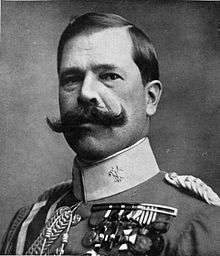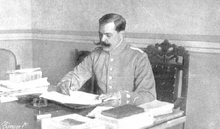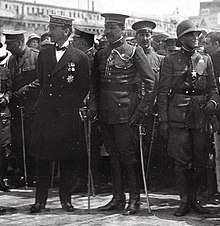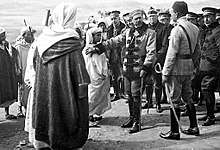Manuel Fernández Silvestre
Manuel Fernández y Silvestre (December 16, 1871 – July 22, 1921) was a Spanish general.
Manuel Fernández Silvestre OAX | |
|---|---|
 | |
| Personal details | |
| Born | Manuel Fernández y Silvestre December 16, 1871 El Caney, Captaincy General of Cuba |
| Died | July 22, 1921 (aged 49) Annual, Morocco |
| Nationality | Spanish |
| Military service | |
| Years of service | 1889–1921 |
| Rank | General |
| Battles/wars | Spanish–American War Rif War |
Silvestre was the son of the lieutenant colonel of artillery Victor Fernández and Eleuteria Silvestre. In 1889 he enrolled in the Toledo Infantry Academy, where he met with the future high commissioner of Spanish Morocco, Dámaso Berenguer.
He committed suicide on the battlefield following the disastrous defeat at Annual of 22 July 1921 suffered by the Spanish army under his command.[1]
Career
Cuba
Silvestre first saw action in 1890 at the age of 19 in a skirmish as a cadet against the Mambises guerrillas seeking independence in Cuba.[2] In February 1895, a full-blown rebellion broke out in Cuba, known as the Cuban War of Independence. After he attended the academy, Silvestre returned to Cuba in 1895 to fight against the Mambises until the Spanish lost the 1898 Spanish–American War in which he received 16 wounds altogether and received a severe incapacity of the left arm that he disguised very well.[3] During his time in Cuba, the aggressive Silvestre had a marked preference for cavalry charges and fighting hand to hand against the Mambises and was widely liked and respected by the men under his command.[2] A charismatic, charming man whose nickname was Manolo, Silvestre was a great womaniser who fathered scores of illegitimate children by the various women he seduced.[3] In the words of the American historian David Woolman: "Silvestre was a real-life character as flamboyant as any to be found in the pages of a romantic novel".[3] Silvestre was a very brave but reckless junior officer in Cuba, where he was seriously wounded during a cavalry action, but as a general, he was hopelessly inept and owned his rapid rise up the ranks to the patronage of his best friend, King Alfonso XIII, who used his position of commander-in-chief to promote his favourite officers.[3][2] After the Spanish–American War, Silvestre served as a military aide to the king, who became his patron.[2] When Alfonso ascended to the Spanish throne in 1886, Spain could at least pretence to be a world power, as Spain had colonies in the Americas, Africa, Asia and the Pacific. The great shattering event of Alfonso's childhood had been the Spanish–American War of 1898, which saw Spain defeated by the Americans and the loss of Cuba, Puerto Rico, the Philippines, and Guam, and shortly afterward, Spain sold the Carolines and Mariana islands to Germany. As a result, Spain's empire now consisted only of Spanish Guinea, in Central Africa, and some footholds on the Moroccan coast. Alfonso had taken the losses of the Spanish–American War very badly and supported the africanistas, who longed to conquer for Spain a new empire in Northern Africa to compensate for the lost empire in the Americas and Asia.[4] As a militarist educated by army officers and an africanista, Alfonso liked swashbuckling, macho generals who might conquer for him an African empire; which explained why Silvestre became a royal favourite.[4] Alfonso was fascinated by Silvestre's flamboyant and colourful personality, which made him popular "both with his troops and with the ladies."[2]
Spanish Morocco
In 1904, after many postings to peninsular regiments, he was dispatched to the Spanish exclave of Melilla on the Mediterranean Rif coast of North Africa, where he proved to be an excellent negotiator but also a fierce and an unpredictable man. In 1912, he occupied Larache and in 1918, he became the Commandant-General of Ceuta. As such he reported to the High Commissioner, a position that was filled by Dámaso Berenguer. Silvestre and Berenguer had once been friends at the military school, but they had fallen out as Silvestre was actually senior on the officer's list although Berenguer's position as High Commissioner meant that Silvestre had to take orders from him.[3] Berenguer regarded Silvestre as reckless but was unwilling to rein him in largely because his friendship with the king, who had the final say over who was promoted and when.[5] Silvestre led several campaigns against Mulai Ahmed er Raisuni, a notorious North Moroccan brigand, from 1913 to 1920. After a long struggle, Silvestre defeated Raisuni in October 1919 in the Battle of Fondak Pass. Although Raisuni and most of his troops managed to slip away, they eventually joined forces with the Spanish authority against rival rebel leader Abd el-Krim. Raisuni's army was key to the Spanish capture of Larache and Arcila and to contain Abd El-Krim's offensives in 1923 and 1924, but he ended up as a prisoner of Abd El-Krim, who had him executed in 1925.[6][7]

After stopping in Ceuta, Silvestre marched in 1920 to take command of the Command of Melilla from where in January 1921 he led the Rif invasion, to stop the local resistance, now led by Abd el-Krim. Berenguer commanded from his headquarters at Tétouan, south of Ceuta, and Silvestre was based at Meilila, 130 miles away, a command arrangement that did not facilitate smooth co-operation between the two generals.[3] In March 1921, Silvestre met Berenguer aboard the old cruiser Princesa de Asturias to plan the operations in the spring.[8] Silvestre dismissed the Moroccans as an enemy, said he had all the troops and equipment that he needed, and causally mentioned: "The only way to succeed in Morocco is to cut off the heads of all the Moors".[8] French Marshal Hubert Lyautey, who commanded the forces in French Morocco, complained that the Spanish lacked sufficient cultural sensitivity and often gratuitously offended the Islamic traditions of the Moroccans by openly engaging the services of the ubiquitous prostitutes, who followed the Spanish Army everywhere in Morocco; by engaging in harassment of Muslims on the streets; by dishonest and bigoted treatment of Moroccan tribal chiefs; and by all too often simply assuming that an "iron fist" approach was the best way to deal with the Moroccans.[8] Lyautey criticised the Spanish Army in Morocco in general, but Silvestre exemplified it perfectly with his arrogance that led him to dismiss the Moroccans as hopelessly inferior and his firm belief in the "iron fist".[5]
The operation was risky and dangerous since the Spanish soldiers were very poorly trained and scared of the Rifians. Silvestre's force comprised 20,000 Spanish soldiers, as well as 5,000 regulares, as Moroccans in the Spanish Army were called.[5] Of the Spanish troops, well over half were completely illiterate conscripts from the poorest elements of Spanish society and had been sent to Morocco with minimal training.[5] Despite Silvestre's assurances that his equipment was sufficient to defeat the Rifians, about three quarters of the rifles at the Melilla arsenal were in shoddy condition because of poor maintenance, and a report from late 1920, which Silvestre had never bothered to read, warned that many of the rifles in Melilla arsenal were unusable or more of a danger to the soldier who was firing them than to the enemy.[9] The average Spanish soldier in Morocco in 1921 was paid the equivalent of US$0.34 per day and lived on a simple diet of coffee, bread, beans, rice and the odd piece of meat.[9] Many soldiers bartered their rifles and ammunition at the local markets in exchange for fresh vegetables.[9] The barracks that the soldiers lived in were unsanitary, and medical care at the few hospitals was very poor.[9] Up in the mountains, Spanish soldiers lived in small outposts known as blocaos, which the American historian Stanley Payne observed: "Many of these lacked any sort of toilet, and the soldier who ventured out of the filthy bunker risked exposure to the fire of lurking tribesmen".[10] Continuing a practice first began in Cuba, corruption flourished in the venal Spanish officer corps, with goods meant for the troops being sold onto the black market, and the funds intended to build road and railroads in Morocco ended up in the pockets of senior officers.[9] A shockingly high number of Spanish officers could not read maps, which explains why Spanish units so frequently got lost in the Rif.[9] In general, studying war was not considered to be a good use of an officer's time, and most officers devoted their time in Melilla in words of the American journalist James Perry to "gambling and whoring, sometimes molesting the native Moorish women".[9] Morale in the army was extremely poor, and most Spanish soldiers just wanted to go home and leave Morocco forever.[9] Because of the prostitutes from Spain, who attached themselves in great number to the Spanish bases in Morocco, venereal diseases were rampant in the Spanish Army, as it was the great dream of many Spanish soldiers to contract a venereal disease so he could invalidated out of service and sent home to Spain.[9] Silvestre was well aware of the poor morale of his soldiers, but he did not regard it as a problem since he believed that his enemy was so inferior that the problems afflicting his troops would not be an issue.[9]

Silvestre had spread out his troops in 144 forts and blockhouses (blocaos) from Sidi Dris on the Mediterranean across the Rif to Annual and Tizi Azza and on to Melilla.[9] A typical blockhouse held about a dozen men while the larger forts had about 800 men.[10] Silvestre, known for his boldness and impetuosity had pushed his men too deep into the mountains hoping to reach Alhucemas Bay without undertaking the necessary work to built a logistical support network capable of supplying his men out in the blocaos up in the Rif mountains.[11] Krim had sent Silvestre a letter warning him not to cross the Amekran River, or he would die.[12] Silvestre commented to the Spanish press about the letter: "This man Abd el-Krim is crazy. I'm not going to take seriously the threats of a little Berber caid [judge] whom I had at my mercy a short time ago. His insolence merits a new punishment".[13] Krim allowed Silvestre to advance deep into since he knew that the Spanish logistics were, in the words of the Spanish historian Jose Alvarez, "tenuous" at best.[11]
In late May 1921, Silvestre had his first inking of trouble, as he received reports that his supply columns he was sending up into the Rif were regularly being destroyed.[13] As Silvestre had pushed his men very deep into the Rif, and his forts and blocaos held little in the way of food, the ambushes threatened to bring down the entire chain that Silvestre had built.[13] On 29 May 1921, Silvestre wrote to Berenguer for the first time that the campaign against Krim might be more than a "mere kick in the pants" and that he needed more troops fast.[13] However, in the words of Perry, "this stupid man" marched across the Amekran River to occupy the village Abaran on June 1, 1921.[13] Most of the soldiers were regulares who promptly mutinied, murdered their Spanish officers and declared that they were now joining the jihad that Krim had proclaimed against the Spanish.[13] After the debacle, Berenguer paid an emergency visit to Melilla to meet with Silvestre to "suggest" the latter to suspend his attempts to push over the Amekran River until Berenguer could "pacify" his zone south of Ceuta and start a supporting offensive from the west.[13] Silvestre wanted to hear nothing of Berenguer's "suggestions" and said that unless he received a direct order to stop, he could continue his attempts to push Spanish power beyond the Amekran.[13] Silvestre was so angry with the "suggestions" that he attempted to attack Berenguer and had to be restrained by the other officers.[13] Though Berenguer continued to "suggest" to Silvestre caution in a steady stream of telegrams over the following days and advised no operations beyond the Amekran, he never ordered Silvestre to stop for fear of angering Silvestre's patron, Alfonso XIII, which meant that the stubborn Silvestre continued to press on.[13]
The local resistance began to believe that they were able to defeat the Spanish when, on June 1, 1921, it took the position from Abarrán, killing many Spanish soldiers in combat. On June 8, 1921, Silvestre again sent his men south of the Amekran to start building a fort at Igueriben.[13] Krim then out a proclamation to all the Berber tribes of the Rif: "The Spaniards have already lost the game. Look At Abaran! They have left their dead mutilated and unburied, their souls vaguely wandering about, tragically denied the delights of Paradise!"[14] The Rifians now surrounded the new Spanish base at Igueriben and used captured Spanish artillery to bring down fire on the Spanish.[15] Then, Silvestre sent a telegram to Berenguer saying that the situation had become "somewhat delicate" and that he desperately needed more troops.[15] Silvestre now started to worry, as he had much trouble sleeping and eating.[15] However, Silvestre's doubts were quietened when King Alfonso sent him a telegram, whose first line was "Hurrah for real men!", and it urged his favorite general to stay the course and not to retreat.[15] With that, any possibility of retreat vanished, as Silvestre would never displease the king.[15]

The Spanish garrison at Igueriben was cut off but could communicate with the fort at Annual via heliograph.[15] From the heliograph, Silvestre learned that the men at Igueriben had no water and been reduced to drinking the juice from tomato cans, then vinegar and ink, and finally their own urine.[15] With the dehydrated men of Igueriben in desperate condition, a relief force from Annual was sent down on July 19 but was ambushed and destroyed, with 152 Spanish killed.[15] On July 21, Silvestre sent down another relief force of 3000 men, which was likewise ambushed and defeated.[15]
Battle of Annual
After the fall of Igueriben on July 22, the rebels attacked the Spanish military camp. Silvestre, who had been acting more and more irrationally since the previous setbacks, ordered Major Julio Benitez to break out, which led to Benitez and most of his men being hacked to death by the Moroccan tribesmen, who rarely gave the Spanish much mercy.[15] Only 11 survivors of Igueriben managed to reach the fort at Annual, and 9 of them died within hours of heat exhaustion.[15] Then, Silvestre fell to pieces, chewed obsessively at his mustache and talked gibberish to himself as he paced back and forth, wondering what he should do.[15] Matters were decided for Silvestre as Krim decided to follow up his victory at Igueriben by besieging the Annual fortress, and a few hours later, his tribesmen had surrounded Annual.[16] At that point, a panic-stricken Silvestre, who having previously underestimated Krim now swung to the other extreme and called a council of war to announce he was ordering a general retreat back to the coast.[16] Silvestre sent his last message on the radio to Madrid at about 4:55 a.m. that he would start a retreat to the coast later that morning.[16] Silvestre failed to organize an orderly retreat, not least because for reasons of machismo, he was unwilling to admit to his men that they would be about to retreat.[16]
At about 10 am on 22 July 1921, the 5000 men of the Annual started to march out of the fort without being told why.[16] As the Spanish marched in such a disorganised fashion with no officers to give them direction or orders that in the words of the British historian Admiral Cecil Usborne: "Units broke up and became incoherent", as men started to head off in every direction amid "the terrible heat and dust of the Moroccan summer".[16] With Spanish having no order, the Moroccans had no trouble cutting them down with writhing fire, which, in turn, led to the Spanish taking off helter-skelter with every man for himself to the mountains.[16] The Rif tribesmen cut them down with their swords, and others were "shot down like rabbits" with the smiling tribesmen openly standing up to shoot down the Spanish as if it was all a game to them.[16] The Rifians used up almost all of their ammunition, but they captured so many Spanish guns and ammunition as to come out of the battle with more ammunition than they had started with.[17] In the meantime, the Rifians had smashed through the gates of the Annual and went about killing every Spaniard they encountered.[16] The Rifians gave no mercy and cut down not only the Spanish soldiers but also the Spanish prostitutes, who had followed the troops up into the Rif.[11] While that was happening, Silvestre stood on the parapet of the Annual fortress, watching his army being destroyed.[16] With the exception of one cavalry unit, the Cazadores de Alcántara, the entire garrison of about 5000 men were lost.[16] Silvestre reportedly further demoralised his men by yelling at them, "Run, run, the bogeyman is coming!" as they attempted to rally following their initial defeat.[18] Silvestre's comments about the "bogeyman" were his only contributions to the command of his army during the Annual battle.[16] Of the 570 Spaniards who survived the "Disaster of Annual", the 326 who were taken prisoner were released in January 1923 after the Spanish state paid a ransom of four million pesetas.[11] The survivors consisted of 44 officers, 236 soldiers, 10 civilians and 33 prostitutes and their children.[11]
Death
According to some witnesses, Silvestre, upon seeing the disaster, went into his tent and committed suicide by shooting himself in the head. Whether dead by his own hand or like most of his staff killed in the turmoil of the retreat, the only remnant of Silvestre appears to have been his scarlet and gold general's sash. Captain Fortea, one of the few Spanish prisoners taken at Annual, reported that Abd el-Krim wore the sash during the pursuit. Abd el-Krim himself told the writer J. Roger-Mathieu that this and other insignia had been brought to him by one of his men.[19]
A total of 15,000 Spanish soldiers fell in the days from July 22 to August 9; most died during the Battle of Annual (known as the Disaster of Annual to Spanish historians). Krim followed up his victory at Annual by laying siege to all of the blocaos in the Riff mountains, none of which had much food or water stored, and all of which he took.[17] After the Annual rout, Spanish morale collapsed and there was very little attempt at organized resistance, with the commanders of every blocao making no effort at any organized retreat.[17] On that final day, Silvestre's deputy, General Felipe Navarro y Ceballos-Escalera, surrendered with his men at the sprawling fort of Mount Arruit.
References
- Henry Marchat Henry. "La France et l'Espagne au Maroc pendant la période du Protectorat (1912-1956)", Revue de l'Occident musulman et de la Méditerranée, no. 10, 1971. p. 84.
- Woolman, David Rebels in the Rif, Stanford: Stanford University Press, 1988, p. 45.
- Perry, James Arrogant Armies Great Military Disasters and the Generals Behind Them, Edison: Castle Books, 2005 page 276
- Perry, James Arrogant Armies Great Military Disasters and the Generals Behind Them, Edison: Castle Books, 2005, p. 274.
- Perry, James Arrogant Armies Great Military Disasters and the Generals Behind Them, Edison: Castle Books, 2005, p. 277
- "{05/10/1919} La conquista del cruce de caminos: "El desfiladero de Fondak" ⋆". El Reto Histórico (in Spanish). 2016-10-05. Retrieved 2017-07-18.
- "Biografia de Ahmed Ben Muhamad Raisuli". www.biografiasyvidas.com (in Spanish). Retrieved 2017-07-18.
- Perry, James Arrogant Armies Great Military Disasters and the Generals Behind Them, Edison: Castle Books, 2005, l. 277.
- Perry, James Arrogant Armies Great Military Disasters and the Generals Behind Them, Edison: Castle Books, 2005 page 278
- Perry, James Arrogant Armies Great Military Disasters and the Generals Behind Them, Edison: Castle Books, 2005 page 278.
- Alvarez, Jose "Between Gallipoli and D-Day: Alhucemas, 1925" pages 75-98 from The Journal of Military History, Vol. 63, No. 1, January 1999, p. 81.
- Perry, James Arrogant Armies Great Military Disasters and the Generals Behind Them, Edison: Castle Books, 2005, p. 279
- Perry, James Arrogant Armies Great Military Disasters and the Generals Behind Them, Edison: Castle Books, 2005, p. 279.
- Perry, James Arrogant Armies Great Military Disasters and the Generals Behind Them, Edison: Castle Books, 2005 pages 279-280.
- Perry, James Arrogant Armies Great Military Disasters and the Generals Behind Them, Edison: Castle Books, 2005 page 280.
- Perry, James Arrogant Armies Great Military Disasters and the Generals Behind Them, Edison: Castle Books, 2005, p. 281.
- Perry, James Arrogant Armies Great Military Disasters and the Generals Behind Them, Edison: Castle Books, 2005 page 282.
- Woolman, David S. Rebels in the Rif: Abd el-Krim and the Rif Rebellion (Stanford: University Press, 1988), 91
- Woolman, David Rebels in the Rif, Stanford: Stanford University Press, 1988 page 91.
Much of the content of this article comes from the equivalent Spanish-language Wikipedia article, accessed April 9, 2007.
External links
![]()